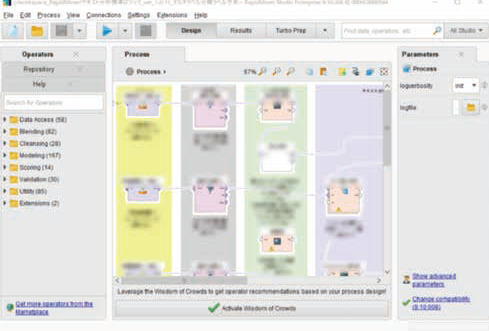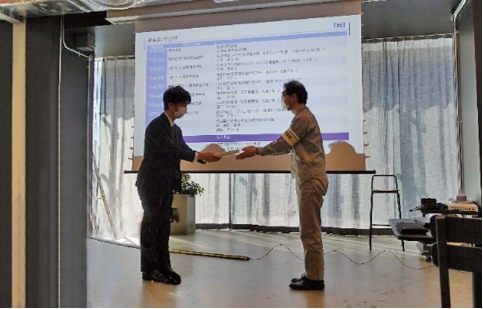Development of Tools and In-House Data Analysts as Foundation of DX Expanding data utilization environments for accelerating digital transformation
IHI Corporation
To speedily create value suitable for each customer, the IHI Group promotes the preparation and development of microservices, which facilitate data utilization, and the fostering of human resources that create value through data analysis.

Introduction
In recent years, it has become increasingly important to offer services suitable for rapidly changing and diversifying customer needs. A company increases its own business value and profit by helping its customers improve their value, and these gains enable the company to provide additional value. This virtuous cycle of customer-oriented business reformation is called customer success, and realizing customer success contributes to society.
To realize customer success, the IHI Group has been making efforts towards digital transformation (DX). One such effort is the following cycle to create value from data. Collecting data as a source for DX, we visualize it as meaningful information. We then create value through problem solving and new discoveries based on data analysis utilizing AI. Repeating this cycle leads to customer success.
As a way of promoting DX, we prepare and develop microservices to expand data utilization environments. We define the term microservices in two ways: first, as a group of functions that provide decoupled functions from applications through the active use of IoT (Internet of Things) and AI technologies, and second, as a system consisting of aggregates of the function groups. We also emphasize human resource development for promoting DX, such as DX leaders, who reform business operations, and in-house data analysts, who analyze and utilize data related to their own business activities. Fostering of in-house data analysts with knowledge of products and business activities as well as of data analysis is essential to utilize data for the products and services of the IHI Group. The IHI Group has already developed more than 650 in-house data analysts. In this article, we introduce these efforts.

Efforts for expanding data utilization environments
With the aim of actively utilizing data to speedily create value, it is important to develop human resources for promoting DX in business divisions, where knowledge of products, services, and customers is accumulated. To provide timely value, engineers not only in the division in charge of IT but also in business divisions must independently analyze data in their respective divisions. Note that introducing standard data analysis tools on a company-wide basis is important to eliminate the inefficiency of having various divisions separately prepare their own data analysis tools. Along with introducing tools, educational training on statistics, machine learning, and data analysis is required to accurately interpret the analysis results obtained with such tools and to actively use the results in business activities.
To meet the above requirements, the IHI Group has been templating the ever-accumulating data analysis techniques as microservices in the company’s standard system. Toward active use of such microservices, we provide training to data analysts so that they can acquire fundamental knowledge, including on data analysis procedures, data visualization, tabulation methods, and methods of building prediction models. Moreover, in order to provide our employees with opportunities to practice data analysis, we have launched an internal contest in which participants compete to achieve the most accurate analysis results for an assigned project. The following explains these efforts in more detail.
Preparation of microservices
Microservices in the IHI Group consist of IHI-developed tools and other companies’ tools. For example, RapidMiner, a commercial tool that aids in performing data analysis, is provided as a company standard tool in order to expand the use of microservices in business divisions. Here, we will introduce various tools and describe how they are utilized.
(1) Low-code/no-code data analysis tool
In general, knowledge of programming languages is required for data analysis. Though engineers in business divisions know a lot about products, services, and issues, they are not necessarily experts in programming languages capable of developing data analysis programs on their own. In recent years, no-code tools, with which people can program without writing commands in programming languages, and low-code tools, with which people can program more easily, have been attracting attention as application development tools (“DX White Paper 2021,” Information-technology Promotion Agency, Japan). The IHI Group has introduced RapidMiner, a low-code/no-code data analysis tool, to help the business divisions analyze data quickly. RapidMiner enables us to build various analysis processes simply by connecting operators, which are boxes of defined data processes. This realizes sophisticated analysis processes — such as data visualization, modeling, evaluation, and operation — without writing code, which is a central feature of the tool. Introducing this data analysis tool has led to autonomous data analysis by personnel in a manufacturing division and other divisions without the involvement of personnel from the division specialized in data analysis.
(2) Templates for business analysis
In addition to standard data analysis methods, original analysis methods are required to provide the IHI Group’s customers with value. To realize such original analysis methods, we developed templates, which are programs that organize process contents, of analysis contents considered to be frequently used within the business activities of the IHI Group. Templates for text analysis and stock optimization are already available and expected to make data analysis in the business divisions quicker and more efficient. RapidMiner enables us to easily customize the analysis methods according to our business activities.

Fostering of data analysts
After preparing microservices as described above, we focused on fostering human resources who can utilize data analysis tools through training programs on data analysis procedures, data visualization, tabulation methods, and methods of building prediction models. It is said that to effectively use data analysis tools, knowledge of data analysis and of business activities as well as the imagination of how to utilize data to improve business activities are necessary.
The following explains the knowledge needed by data analysts alongside the flow of data analysis. Knowledge of products and business activities is considered vital for setting objectives and hypotheses prior to processing data. Knowledge of statistical analysis and machine learning is important in processing data. After data is processed, a report (decision) is made based on the results. Knowledge of products and business activities is a key element in this reporting process as well. Consequently, it is necessary to foster human resources who are equipped with a broad range of knowledge.

Thus far, we have conducted various programs for human resource development to promote DX in the business divisions. In 2018, aiming to improve skills in AI and data analysis in the business divisions, we launched a training program on how to use the data analysis tool introduced on a company-wide basis in collaboration with its developer. We also provide a course for managers on our human resource development activities to help spread a corporate culture of actively utilizing AI and data analysis. Other programs include a course on AI and data analysis in which participants learn data analysis methods in a hands-on manner; the aim is to enable them to actually conduct data analysis in their business activities. In 2021, we added training on how to proceed with data analysis projects and knowledge of relevant laws as part of improvements to the course. As of March 2022, 650 members of the IHI Group had attended the course on AI and data analysis. By taking a test after the course, successful participants are certified as in-house data analysts. We will continue to offer the course and plan to attract several hundreds of participants from the business divisions. In addition, we provide networking opportunities to those who have completed the course so that they may exchange information and develop advanced courses as part of follow-up activities. More specifically, we run a community for facilitating exchanges between in-house data analysts and AI Portal, which is a website for introducing examples of AI utilization in the IHI Group and for providing consultation services on AI utilization.
Despite these efforts, we sometimes heard from course attendees that they could not effectively use the knowledge they obtained from the course to solve problems in their business activities and also from the supervisors of attendees that the supervisors did not understand what tasks to assign the attendees so that they could utilize their data analysis knowledge in their actual business activities. As a result of our survey, we concluded that it was our challenge to deepen the understanding of not only the attendees but also their supervisors regarding the importance of AI and data analysis in business activities. To address this challenge, we held a workshop intended to enhance supervisors’ understandings and to share awareness between course attendees and supervisors. Approximately 400 members, including both course attendees and supervisors, attended the workshop and learned about the flow and key points for effective use of AI and data analysis in their business activities. At this workshop, they discussed how they could use AI and data analysis in their workplaces, thus deepening understanding of the importance of AI and data analysis in the business divisions.
In-house data analysis contest
We launched an in-house data analysis contest called AI Contest to provide in-house data analysts and other employees interested in data analysis with opportunities to practice data analysis and interact with each other. We have already held AI Contest three times; the topics were image analysis, text classification, and spectral data analysis. We intend to have contestants acquire data analysis skills by tackling challenges in various areas. In particular, for the third contest on the topic of spectral data analysis, we provided e-learning contents on the analysis method using the introduced no-code data analysis tool to enable beginners who do not use data analysis in their daily business activities to readily join in.
Contestants numbered approximately 30 for the first contest, 50 for the second, and over 200 for the third. This steady increase in the number of AI Contest contestants reflects rising employee interest in data analysis. In addition, contestants can deepen their understandings and interest in data analysis methods through video presentations made by the prize winners describing how they addressed the topic. As described above, holding the AI Contest invigorates the in-house community, where knowledge and wisdom assemble. The IHI Group is well on the way to establishing a structure for problem solving with data analysis.

Conclusion
Promoting DX and fostering human resources are necessary to transform our business through the active use of digital technology and to realize customer success throughout the IHI Group. Based on the efforts described in this article, we will place greater focus on developing microservices and human resources for data analysis, such as in-house data analysts, from the perspective of promoting data analysis and utilization. Furthermore, to provide additional new value for customers, we will realize customer success by repeatedly iterating the cycle to create value from data.
